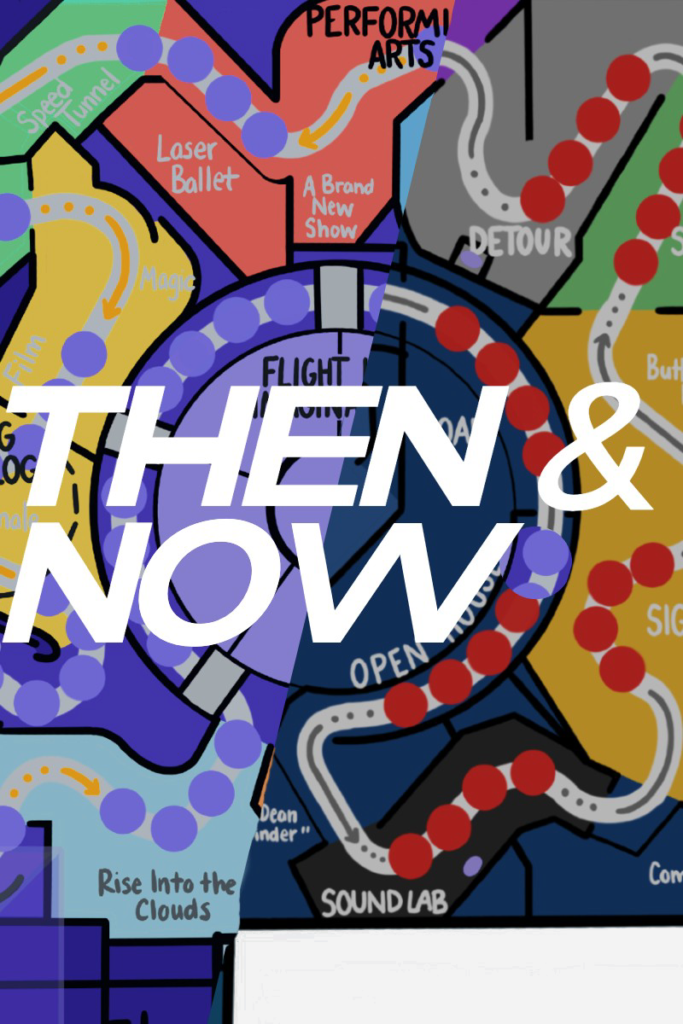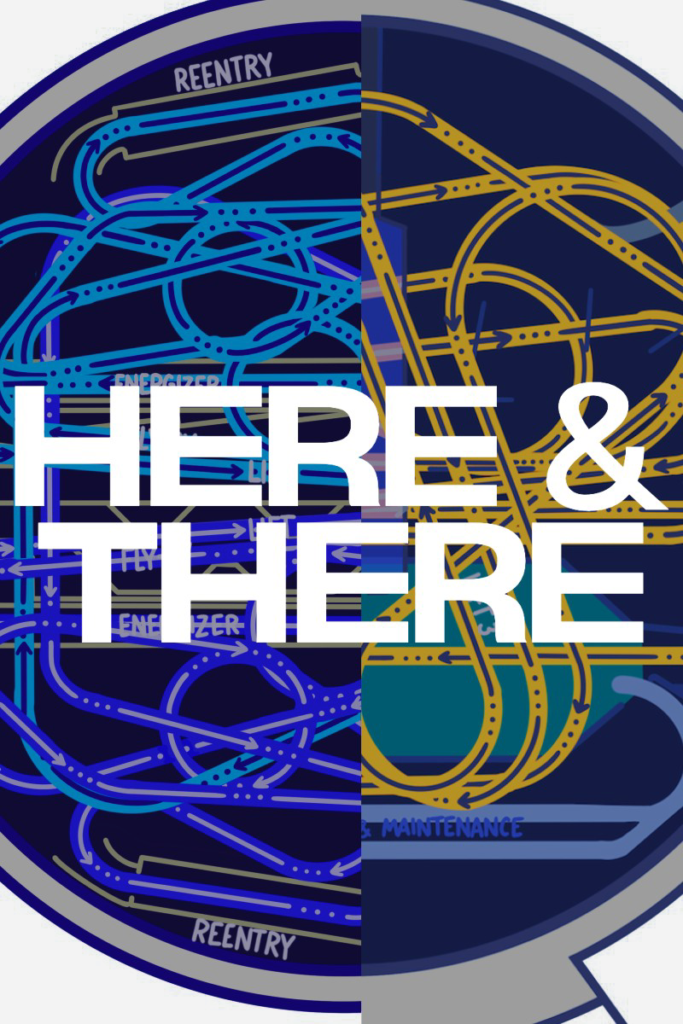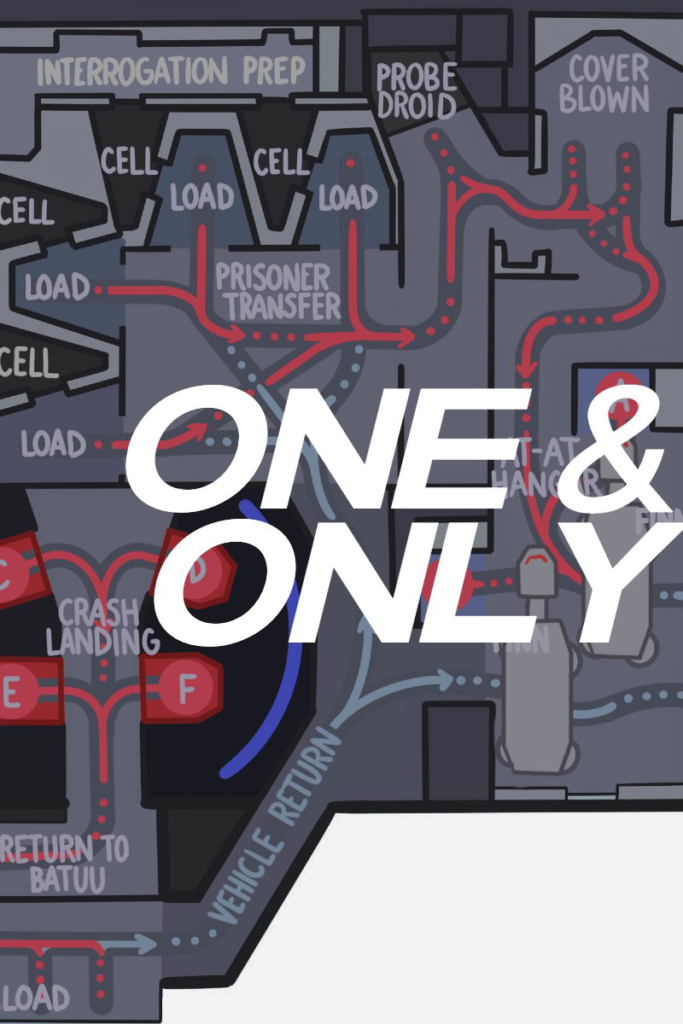18. Web-Slinging Adventures
Disney purchased Marvel in 2009, and within a decade, had officially grown Marvel Studios’ “Marvel Cinematic Universe” into one of the top ten highest grossing franchises of all time. Given that, it’s surprising how slowly Marvel was integrated into Disney’s theme parks – and mostly in the form of piecemeal overlays to existing rides. It wasn’t until 2019 that Disney formalized their plans for the heroes by way of three distinct lands en route to Disney’s three underbuilt parks from the early 2000s: California Adventure, Walt Disney Studios Park in Paris, and Hong Kong Disneyland.
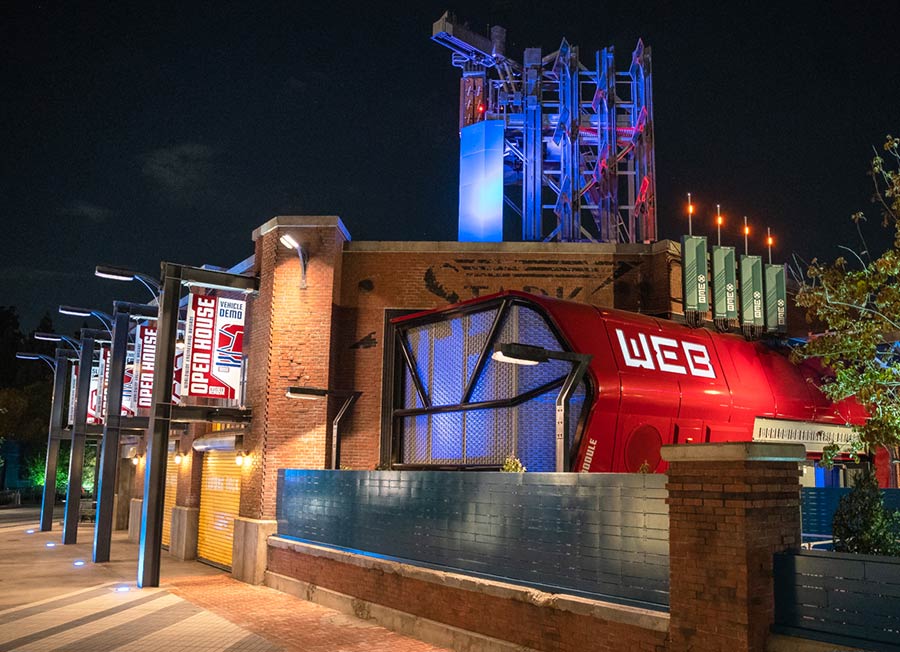
The former two parks’ Marvel presence both take the form of “Avengers Campus” – a sort of flex-space land dedicated to the recruitment and training of the next generation of heroes (that’s us). Both are anchored by Marvel rethemes of existing headliners for their respective parks, but both also feature nearly-identical supporting rides themed to Spider-Man. The “Web Slingers” rides invite guests into the Worldwide Engineering Brigade – a cohort of grad school whiz kids – to test out a prototype new technology that allows people to “sling webs” just like Spider-Man.
Fans have been quick to criticize Disney’s duplicated Spider-Man rides for being entirely screen-based and – especially at California Adventure – re-using the same basic premise as a ride that exists just a few hundred yards away: Toy Story Midway Mania. But to be fair, Avengers Campus did need a no-height-requirement, all-ages ride. Plus, it’s really the gesture-recognition technology that’s the starring character here. And frankly, Disney couldn’t beat Universal’s Modern Marvel: The Amazing Adventures of Spider-Man anyway.
A. Web-Slingers: A Spider-Man Adventure (Disney California Adventure, 2021)
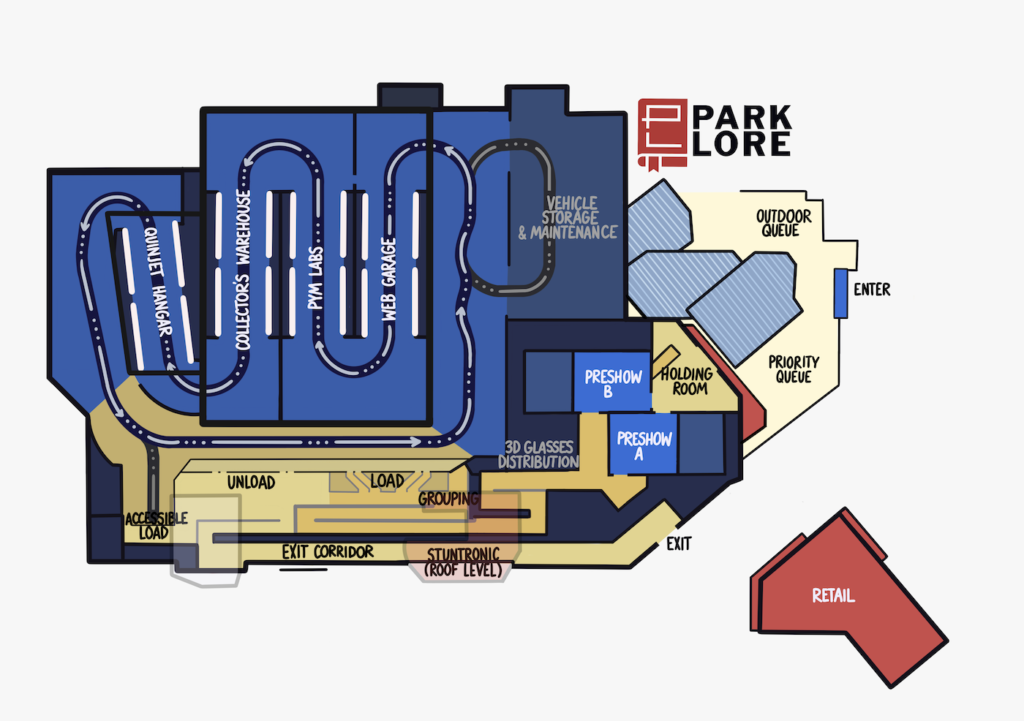
At Disney California Adventure, Avengers Campus was constructed on the remains of “a bug’s land” – a mini-land engineered shortly after the park’s opening to address its lack of family attractions. Ironically, the 3-D theater that once hosted “It’s Tough to be a Bug” became home to another bug-themed attraction when Web Slingers debuted in 2021.
Interestingly, the “Bug” theater wasn’t demolished. Instead, the arching auditorium showbuilding was retained, and the ride engineered in such a way that its screen-based elements are housed entirely within the old theater and lobby space. New additions or expansions to the existing structure provide square footage for the ride’s station, storage, and pre-shows. California’s pleasant climate allows the entire queue to be held in an outdoor courtyard.
That’s lucky, because backwards engineering Avengers Campus to shoehorn into the small, six-acre “bug’s land” plot meant some serious compromises – evident in the land’s surprisingly small retail outlet, and the humorous way that the ride’s exit corridor goes to great lengths (literally) to have guests exit across the street from it.
B. Spider-Man W.E.B. Adventure (Walt Disney Studios Park, 2022)

The second Avengers Campus opened at Disneyland Paris’ beleaguered second gate – the Declassified Disaster: Walt Disney Studios Park – as part of its multi-year, multi-land expansion. There, the ride was a from-scratch build, not restricted to an existing 3D theater. But Paris’s version of the ride is an exact duplicate of California’s anyway. The differences lie in the rest of the structure, where the French ride was able to incorporate more room for a (climate-required) indoor queue, less squished pre-shows, a larger space for vehicle storage, and yes, a proper gift shop to properly exit through.
Notably, the premise of the ride is that – when an army of self-replicating Spider-Bots runs amok – guests must hop aboard prototype WEB SLINGER vehicles and descend into the old Stark Motors utility sub-floors that connect beneath the repurposed buildings of the Campus to capture them. It’s a clever premise that serves as something of a “preview” for the land’s other rides and settings. Of course, the copied ride in Paris includes a visit to the Collector’s fortress… even though Walt Disney Studios’ version of Avengers Campus doesn’t include Guardians of the Galaxy – Mission: BREAKOUT!
To be fair, neither version of the land has the long-rumored Quinjet U-Ticket thrill ride Bob Chapek promised was coming in a “Phase II” of the land… but both still feature climactic scenes that take place in the Quinjet hangar! Oh well. Disney has referenced their ability and interest in keeping both Web Slingers’ scenes updated to reflect new additions and changing attractions within the lands, but whether or not that’ll happen remains to be seen… and might depend on how many add-on accessories the ride manages to sell.
19. STAR TOURS

When the Lost Legend: STAR TOURS opened at Disneyland in 1987, the ride was like nothing seen before… not only because it used cutting edge flight simulator technology to contain the entire Star Wars universe in a relatively small footprint, but because it was the first E-Ticket of then-CEO Michael Eisner’s “Ride the Movies” era, when Disney Parks made a lightspeed jump back into pop culture. Long before Disney owned Star Wars, the ride was a radical divergence from anything the parks had featured before, bringing modern characters to Disney Parks…. even though they weren’t Disney characters!
A. STAR TOURS (Disneyland, 1987)

The original Star Tours is also the smallest. That’s because the 1987 ride was built in the hollowed out showbuilding along Disneyland’s Tomorrowland entryway that had once held the Lost Legend: Adventure Thru Inner Space. You can see exactly how the first ever Omnimover dark ride maps onto the STAR TOURS layout in our THEN & NOW feature, but one famous element that did not change is the ride’s first queue room, which re-used the same descending ramp as its predecessor.
To be honest, it’s a tight fit. Disneyland’s ride manages to squeeze in four ATLAS simulator pods, but as anyone who’s visited the California version of Star Tours will tell you, both the loading and unloading areas are almost hilariously cramped. As with all re-used ride spaces, though, Disneyland’s Star Tours floor plan is the most interesting because it’s the most full of solutions.
B. STAR TOURS (Disney’s Hollywood Studios, 1989)

Disney’s Hollywood Studios opened without a STAR TOURS, but by December of its opening year, the E-Ticket had arrived. Unlike Disneyland’s version that was reverse engineered to fit an existing showbuilding, Florida’s was built from scratch. That means that designers were able to take the puzzle pieces they’d invented for Disneyland’s version and think more intentionally about how to fit them together.
So you’ll find that Hollywood Studios’ Star Tours is the same basic premise, but arranged a little more precisely than the backwards-designed California version. The iconic “Inner Space” entry sequence remains, but is expanded to hold more guests; the second queue room is rearranged, keeping the entire line in a lower-roofed portion of the showbuilding. The load and unload areas are expanded to provide some breathing room, and even the ramps to board and disembark from the simulators are straight bridges instead of the space-saving diagonal ones in California.
The biggest difference most guests would notice between the two STAR TOURS, though, is that the line should move more quickly in Florida. There (as in subsequent from-scratch installations in Tokyo and Paris), the ride’s capacity is increased by 50% by offering six simulator pods rather than California’s four.
20. “it’s a small world“ after all
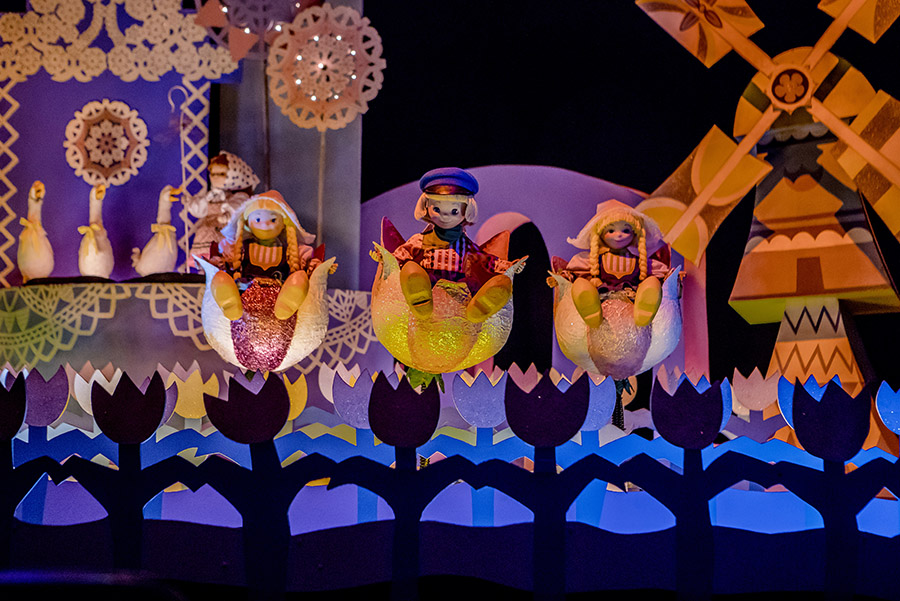
In California, Florida, Japan, France, and Hong Kong, “it’s a small world” is one of the most iconic and beloved Disney attractions on Earth. “The Happiest Cruise That Ever Set Sail” owes so much of its landmark status to Disney Legend and Imagineer Mary Blair, whose sense of color and harmony gives the ride its unmatchable aesthetic. Add in the textile work of the incomparable Imagineer Alice Davis and the songwriting chops of the beloved Sherman Brothers and you’ve got a ride duplicated in almost every “Castle Park.”
A. “it’s a small world” (Disneyland, 1966)

Disneyland’s version of “it’s a small world” is the original, with many of its interiors relocated from the 1964 – 65 New York World’s Fair. That said, the ride’s physical flume and layout are original to the park, and additional scenes were added for its permanent installation there. Still, Disneyland’s ride is a landmark. Thanks again to Southern California’s perpetually-pleasant climate, riders board outdoors beneath the gorgeous, kinetic facade and iconic glockenspiel designed by former Imagineer Rolly Crump, then drift through gardens of fanciful topiaries before passing beneath the Disneyland Railroad and entering the show itself.
In 2008, the ride underwent a significant refurbishment that enabled easier transition to the “it’s a small world holiday” annual overlay, (controversially) added Disney and Pixar characters in Mary Blair style to the ride’s scenes, and replaced the original 1964 flume (allegedly, in part due to age, and in part because the increasing average weight of Americans necessitated a deeper trough to prevent boats from getting beached). Otherwise, this “it’s a small world” remains the ride’s truest form.
B. “it’s a small world” (Magic Kingdom, 1971)

Obviously, Florida’s weather prevented many of Disneyland’s rides from being built as exact clones, since covered queues and weather-proof boarding areas are needed to protect guests and rides from staggering heat, daily thunderstorms, and the occasional hurricane. “Small world” was heavily modified for Florida. There is no outdoor section of the ride. Instead, guests enter via the same pastel tournament tent style that the rest of Fantasyland uses, then descend down ramps into a loading platform at Utilidor level. (A condensed version of Crump’s iconic facade was added to the loading area in 2005.)
With a custom-made showbuilding and a from-scratch build, Magic Kingdom’s layout is similar to Disneyland’s, but more organized, simplified, and (with no need to pass under the Railroad), without the “Hello” and “Goodbye” scenes. The most immediately noticeable changes between the two are that Magic Kingdom’s ride has yet to receive the Disney and Pixar characters that have been added in Anaheim, Hong Kong, and Tokyo, and that in Florida, the ride building is flooded rather than in Disneyland, where a raised fiberglass trough passes through dry scenes.
21. The Twilight Zone Tower of Terror
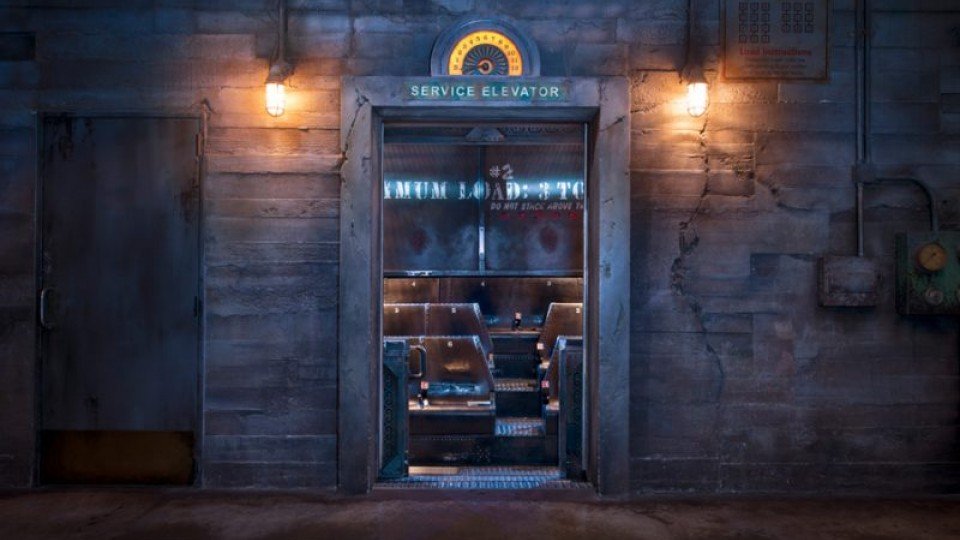
There are four highly-themed Disney dark ride / drop towers out there. One of them is one-of-a-kind. Three of them share the same operational skeleton. But all four offer vastly different experiences thanks to the stories they tell and how they tell them.
A. The Twilight Zone Tower of Terror (Disney’s Hollywood Studios, 1994)
Looming over Sunset Blvd. at Disney’s Hollywood Studios, the Modern Marvel: The Twilight Zone Tower of Terror at Walt Disney World opened in 1994. The ride is remarkably complex, and made of multiple, seamlessly-interwoven ride systems. When guests step aboard a “maintenance service elevator” in the boiler room of Hollywood Tower Hotel, they’re unknowingly strapping onto an Autonomous Guided Vehicle (AGV) that’s parked aboard a Vertical Vehicle Conveyance (VVC).
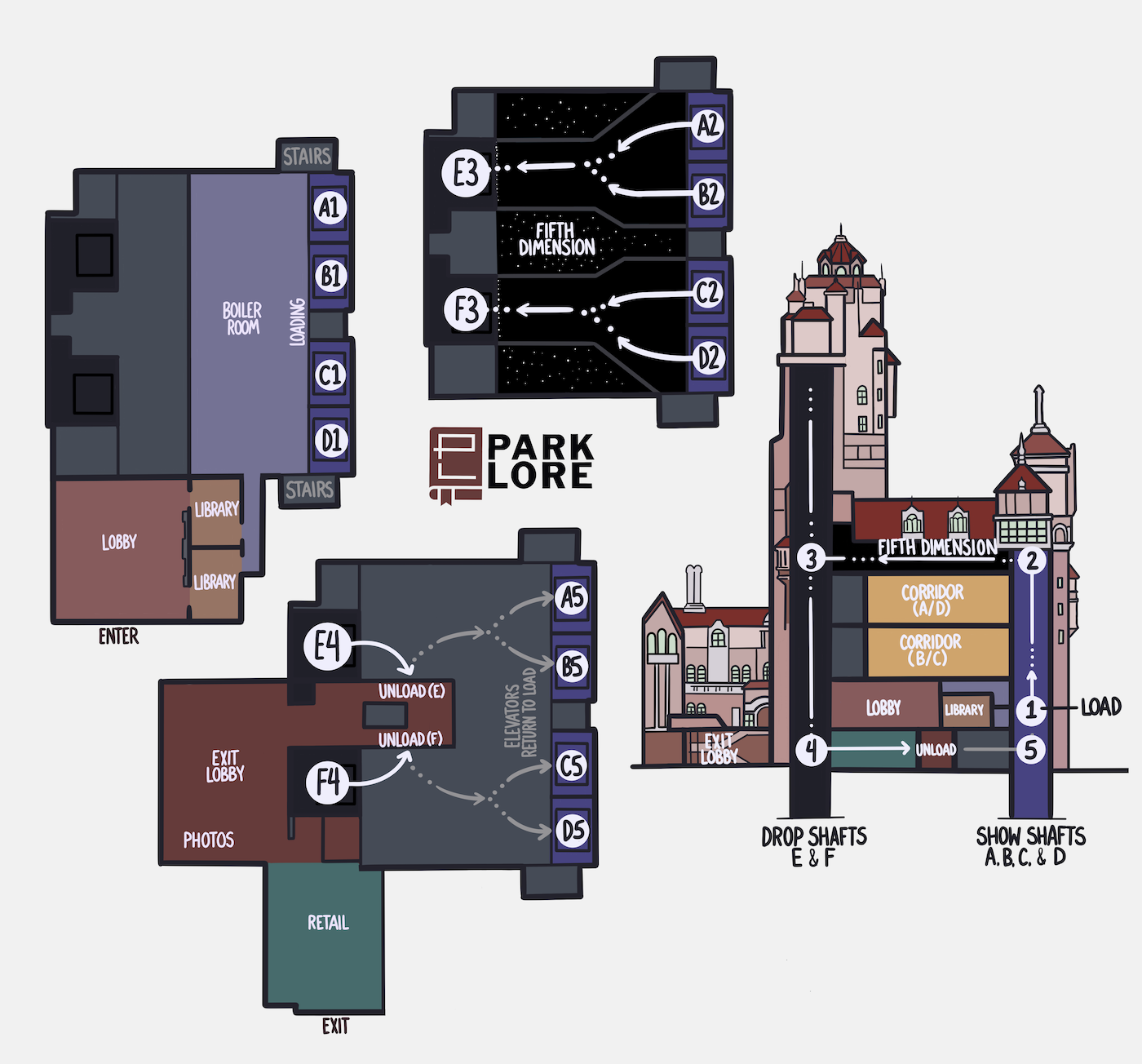
The VVC carries the AGV up through one of four “show shafts” (Alpha, Bravo, Charlie, or Delta) at the rear of the building until it reaches one of two “Fifth Dimension” scenes. There, in a discombobulating, otherworldly, and unexpected moment, the AGV advances out of the VVC, driving itself horizontally toward the front of the building, funneling the four show shafts into a high speed VVC in one of two “drop shafts” (Echo and Foxtrot).
At the end of the drop sequence, the VVC lowers to the basement, where the AGV backs out, rotates, and aligns with an unloading platform. Once guests have stepped off, the empty AGV then backs away and returns itself to the show shaft, rising up to the Boiler Room to collect the next group of riders.
The continuously flow of trackless, self-guided vehicles through the system is an incredible ballet. The Fifth Dimension scene is eerie, disorienting, and surprising, and housing the ride’s show scenes in a showbuilding behind the drop tower itself gives the building a steep cliff face of a facade. Earning our Rewind Award for the ’90s and standing as an icon of the “Ride the Movies” era, the original Twilight Zone Tower of Terror is a legend for a reason.
B. The Twilight Zone Tower of Terror (Disney California Adventure [2004 – 2017] and Walt Disney Studios Park [2007])
When Disney California Adventure opened in 2001, the park wasn’t exactly a hit with guests or the press. In fact, we took a tour of the cringey, comically-underbuilt park in an epic, three-part feature for the ages. Pretty quickly, designers were tasked with stuffing the park with things that would yield quick returns in attendance. A copy of the Twilight Zone Tower of Terror was a such a natural fit for Disney’s California Adventure, it’s shocking that it wasn’t included to begin with. But to make it work with the park’s limited budget, the ride system was rebuilt from the ground up.
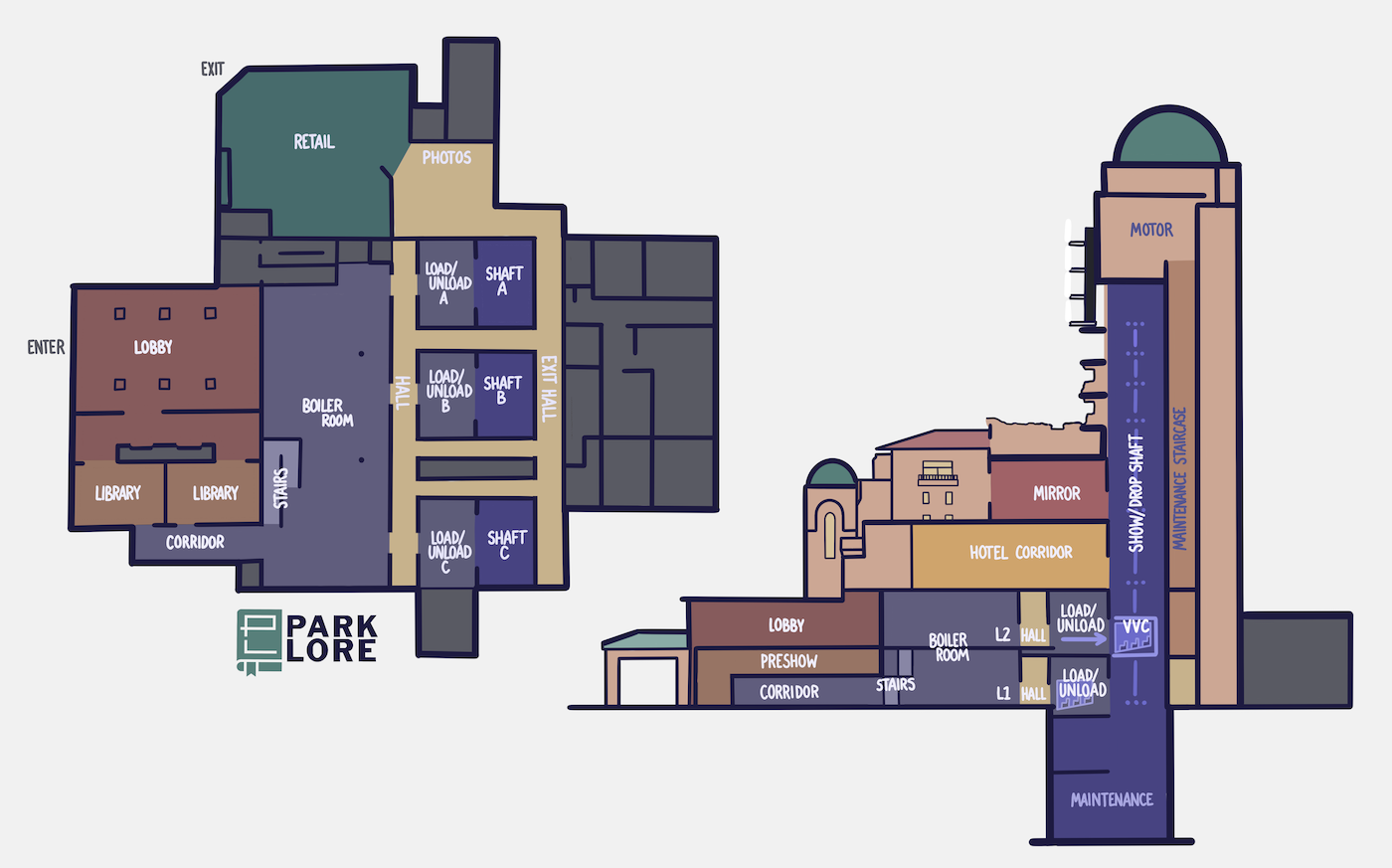
This “budget” version of the Twilight Zone Tower of Terror has some significant advantages. For one, it’s highly efficient. There are three ride shafts (in which both the “show” and “drop” take place), each served by an upper and lower level in the Boiler Room. That means that three elevators can be in the “ride” at any given time, while three elevators are actively unloading or loading. Since all three essentially operate as standalone rides, if one is down for maintenance, the ride’s capacity is only cut by a third (rather than half in Florida). Because the “show” and “drop” both happen on the same nimble VVC, even the “show” portion of the ride is zippy with quick acceleration between floors, shuddering motion, and the surprise of not knowing when the “drop” sequence will drop.
In Disney’s eyes, it’s also an “advantage” that this version of the ride doesn’t have a Fifth Dimension scene, which adds tremendous expense and complexity to the ride. The “DCA model” of the Twilight Zone Tower of Terror still has a moment when the elevators move horizontally, but it’s for a very different reason. When an elevator is loaded and ready, it’s physically pushed backward into a waiting VVC. When it returns to its level of the Boiler Room at the end of the ride, it’s grabbed and pulled back flush with the loading doors. Then the VVC moves to the other loading level, where the process is repeated with the elevator that had been loading.
It also has some disadvantages. Since elevators return to where they loaded and riders need to exit before a new group can board, an auxiliary hallway separates the ride from the Boiler Room loading level. That means that the “elevator doors” in the boiler room don’t open directly into an elevator. Without the Fifth Dimension scene, the bulky, boxy showbuilding has to be moved to the front of the tower, which severely reduces its physical intimidation factor. Plus, the ride is shorter and lacks the same anxiety-inducing build-up.
Though the “low budget” Tower of Terror may lack some of the bells and whistles of the Orlando original, there’s no doubt it’s still an E-Ticket. More to the point, the California model made the ride a whole lot easier to reproduce. After being used to lure guests into the underperforming California Adventure, a clone opened at the similarly-underbuilt Declassified Disaster: Walt Disney Studios Park in Paris in 2007.
C. Tower of Terror (Tokyo DisneySea, 2006)

In 2006, a version of the ride opened at Tokyo DisneySea, too. It’s the same physical ride as California and Paris’, but its “wrap” is drastically different. Since there’s very little cultural association with The Twilight Zone in Japan, designers invented a whole new story for the ride, revolving around a New York hotel magnate, S.E.A. member, and art thief whose cursed collection of stolen global artifacts turns on him.
We took a ride into the mysteries of Tokyo’s ride in its own Modern Marvels: Tower of Terror feature – the perfect place to dig deep into the legend of the Hightower Hotel…
For supporting Park Lore’s ad-free, quality-over-quantity theme park storytelling for $2 / month or more, Members can view Tokyo’s Tower of Terror’s layout above! For everyone else, you’ll find this unique version of the ride in our ONE & ONLY layout collection!
Guardians of the Galaxy – Mission: BREAKOUT! (Disney California Adventure, 2017)
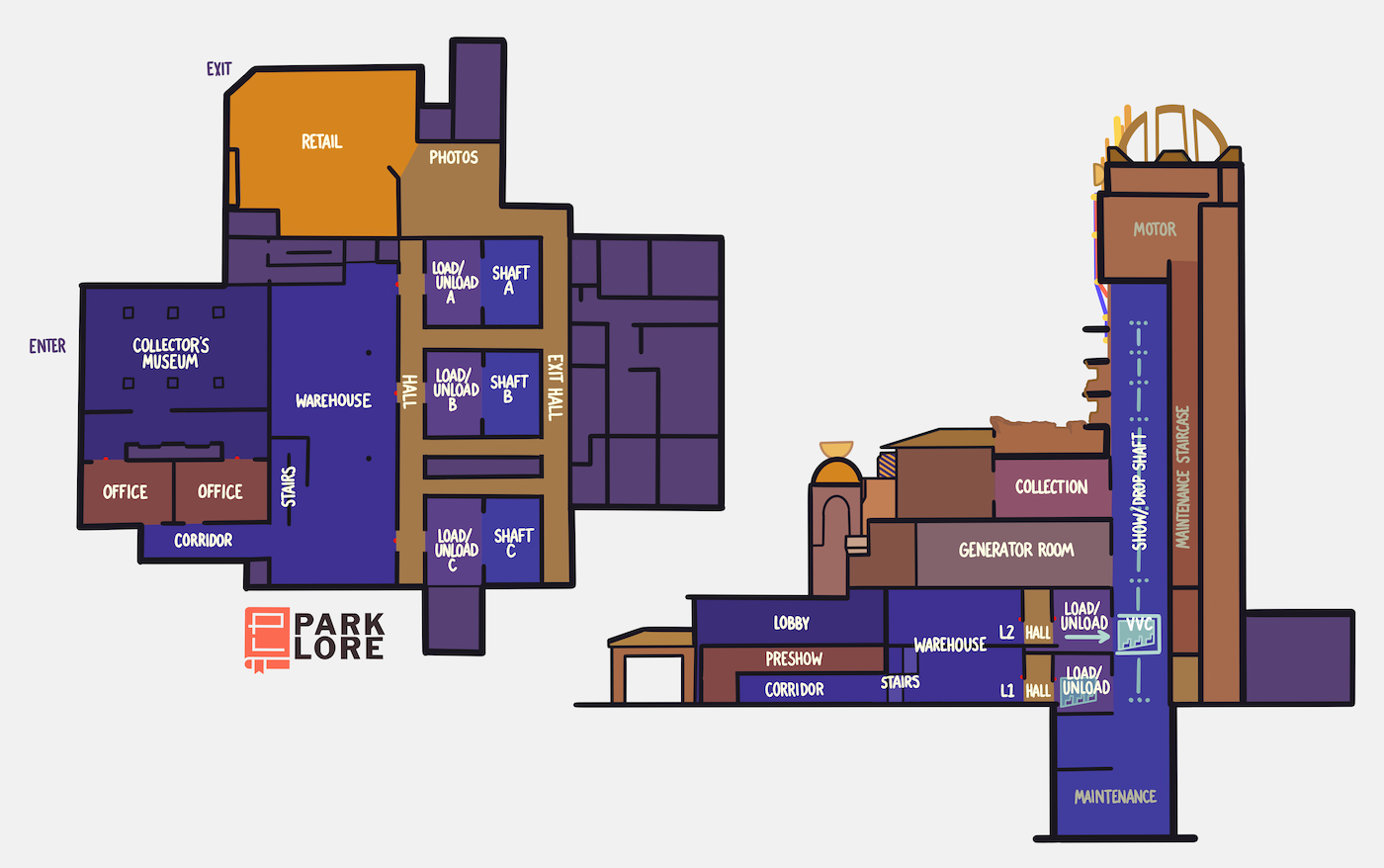
Finally, the fourth version of the ride is really the second version of the ride, reimagined. At the 2016 San Diego Comic Con, legendary Disney Imagineer Joe Rohde was on hand with the weirdest announcement ever: Marvel’s quirky, irreverent, rock ‘n’ roll superhero team – the Guardians of the Galaxy – would soon overtake “the structure housing the Twilight Zone Tower of Terror.” In a blisteringly-paced six month redesign, California’s art deco Hollywood Tower Hotel was grafted with pipes, satellite dishes, and warning stripes as its interior was transformed into the “warehouse prison power plant” of the “Collector” character seen briefly in the 2014 surprise hit superhero film.
Just like that, California’s ride joined our in-depth collection as the Lost Legend: The Twilight Zone Tower of Terror. In its place stood Guardians of the Galaxy – Mission: BREAKOUT! The resulting ride is an absolute blast, deftly repurposing the ride’s “zippy” mechanics to merge “show” and “drop” into one, bobbing and blasting and plummeting to songs like Pat Benatar’s “Hit Me With Your Best Shot,” the Jackson 5’s “I Want You Back,” and Elvis’ “Burning Love,” with randomized ride sequences and different screen-based escapes every time.
How does a “warehouse prison power plant” modeled after “the beauty of a oil rig” look rising over Buena Vista Street? Does “Mission: BREAKOUT!” make more sense in Disney California Adventure via the context of Avengers Campus like we were promised? Will it be as timelessly relevant in twenty years as the Tower of Terror would’ve been? Bad, no, and probably not. But oh well. It’s a rip-roaring good time, and an interesting adaptation of the ride system, perfectly representative of Imagineering’s IP-focused mandate.
More to the point, it’s a great example of just how different two rides can look between Here and There…
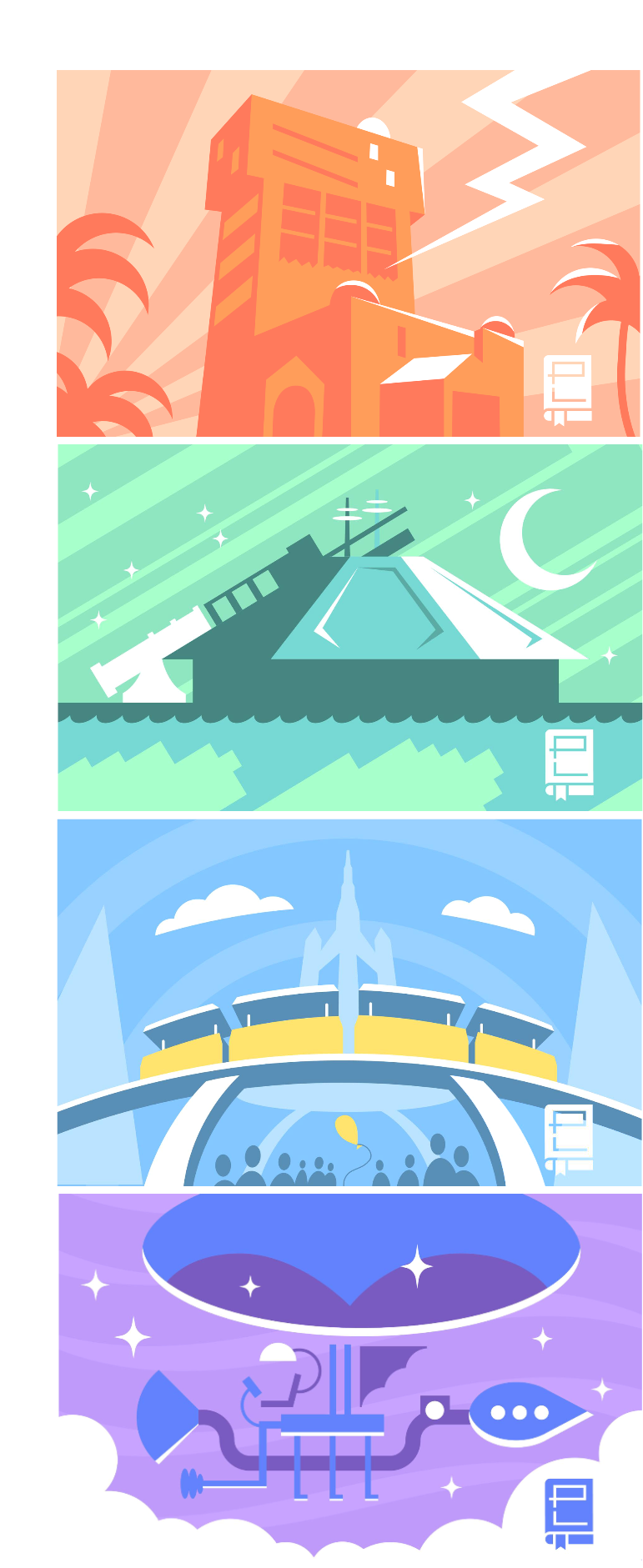
Want to get a sneak peak at the last round of hand-drawn ride layouts I’ve been working on, including TRON Lightcycle Power Run, Radiator Springs Racers, Millennium Falcon: Smugglers Run, Harry Potter and the Forbidden Journey, and Star Wars: Rise of the Resistance?
For supporting Park Lore’s ad-free, quality-over-quantity theme park storytelling mission, Gold & Platinum Members can make the jump to the third and final collection of ride layouts – ONE & ONLY – right now! If you can comfortably do so, consider becoming a supporting Member today to power more projects like this one and to help keep this one-person site going strong!



